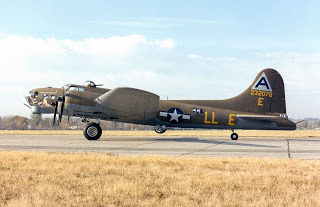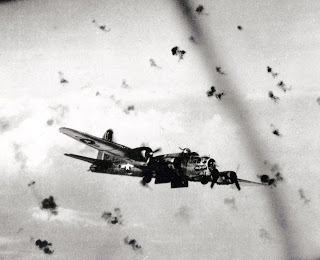Sarah Sundin's Blog, page 523
April 25, 2011
The B-17 Flying Fortress, Part 1
 B-17 Shoo Shoo Baby of the US Air Force Museum, Dayton OH
B-17 Shoo Shoo Baby of the US Air Force Museum, Dayton OH(USAF Photo)Few World War II airplanes have captured the imagination like the Boeing B-17 Flying Fortress.
Next Monday, May 2, I'll have the privilege in taking a flight in Aluminum Overcast, the restored B-17 owned by the Experimental Aircraft Association (http://www.b17.org/). Over the next three weeks, I'll run a three-part series on the legendary Flying Fortress - a starring side character in my novels. Today I'll talk about the plane, next week about the crew, and the following week I hope to share photos and video from my flight.
Development
In 1935, the US Army called for a multi-engine, long-range, high-altitude heavy bomber. On July 17, 1935, Boeing introduced Model 299, which made its maiden flight on July 28, exceeding Army specifications. With plenty of machine guns, it was dubbed the "Flying Fortress" by a reporter. Although Model 299 crashed on an early flight, Boeing received a contract to develop the YB-17 in 1936.
Improvements were made with each successive model - the B-17B in October 1939, the B-17C in July 1940, and the B-17D in February 1941. The C and D models were involved in America's entry into World War II - shot up on the ground in Hawaii and the Philippines and flying early bombing missions. Since a squadron of twelve B-17Ds was expected in Pearl Harbor early on December 7, 1941, when radar showed the approaching Japanese planes, the officer in charge dismissed the warning.
 USAF Photo Combat Models
USAF Photo Combat ModelsThe B-17E rolled out in September 1941, the first model to sport the distinctive bell-shaped vertical stabilizer (tail fin). This model was used in the Eighth Air Force's first combat missions over Nazi-occupied Europe in late 1942. Further refinements led to the F model in August 1942. One of the most famous B-17Fs was the Memphis Belle, the first plane and crew to finish 25 missions in Europe.
Since no one expected dangerous head-on fighter attacks, the F model had weaker .30 caliber guns in the nose rather than the .50 caliber guns used in the rest of the plane. In addtion, the nose guns could not be trained to twelve o'clock. The Luftwaffe quickly discovered this deficiency and adopted head-on attacks with devastating results to the Eighth Air Force. Desperation and ingenuity led airmen to shatter holes in the nose of the plane and suspend a .50 caliber gun with racks and retractable cords. Later B-17Fs incorporated a factory-installed .50 caliber nose gun and eventually a chin turret with two .50 caliber guns.
The last and most common model, the B-17G, entered combat in September 1943, but further refinements were made throughout the war.
Specifications
With a wing span of 103 feet and a length of 74 feet, the B-17G cut a graceful figure. Powered by four Wright R-1820 Cyclone engines, it could carry a crew of ten and a bomb load of up to 8000 pounds (but less on long-distance missions). The B-17G had a top speed of 302 mph and a ceiling of 36,400 feet. Depending on the model and theater of operations, B-17s carried ten to thirteen machine guns.
The B-17 was the first plane to use turbo-superchargers, which boosted engine performance at high altitude. The plane also featured the Norden bombsight, a complicated piece of machinery that allowed the bombardier to compensate for airspeed, wind speed, and drift when bombing. Purported to drop a bomb in a pickle-barrel, the Norden never reached that accuracy in combat, but did allow successful high-altitude, daylight strategic bombing.
Published on April 25, 2011 05:00
Today in World War II History
70 Years Ago—Apr. 25, 1941: German troops under Rommel take Halfaya Pass on Egypt-Libya border and enter Egypt.
Published on April 25, 2011 03:00
April 24, 2011
Today in World War II History
70 Years Ago—Apr. 24, 1941: As Germans advance, British forces in Greece begin evacuation to Crete and Egypt; 50,000 troops will be evacuated.
Published on April 24, 2011 03:00
April 23, 2011
Today in World War II History
70 Years Ago—Apr. 23, 1941: King George of Greece and his government evacuated to Crete as Germans advance. Charles Lindbergh speaks to 30,000 in New York, in the first mass meeting of the isolationist America First Committee; condemns Britain for war.
Published on April 23, 2011 03:00
April 22, 2011
He Is Risen Indeed!

Do you ever worry that you've heard the Easter story so many times, it might grow to feel stale?
The good thing about maturing as a Christian is ease and comfort with God's love, the bad thing is the danger of taking His love for granted.
The apostle Paul never seemed to take Jesus' sacrifice for granted. In Ephesians chapter 1, he lists God's blessings in long run-on sentences overflowing with enthusiasm and joy. He offers a prayer for the reader to grow in the knowledge of God.
"I pray also that the eyes of your heart may be enlightened in order that you may know the hope to which he has called you, the riches of his glorious inheritance in the saints, and his incomparably great power for us who believe. That power is like the working of his mighty strength, which he exerted in Christ when he raised him from the dead and seated him at his right hand in the heavenly realms" (Ephesians 1:18-20).
This Easter weekend, ponder the hope, the inheritance, and the power He gives us. Think about that power. Jesus lay in His grave, His heart still, all metabolic functions stopped, every cell no longer functioning. Friday night, all day Saturday. Then Sunday before dawn, the power of the Father did its mighty work. Jesus' heart jolted awake, the chemicals resumed their flurry of activity, every cell returned to work - but in a new way, different than in our mortal bodies, immortal, never to cease again.
That same power works in us. That same power is available to us. That same power can resurrect a stale faith and bring back joy and enthusiasm.
He is risen! He is risen indeed!
Published on April 22, 2011 05:00
April 21, 2011
Today in World War II History
70 Years Ago—Apr. 21, 1941: Greek First Army surrenders to Germans in northern Greece.
Published on April 21, 2011 03:00
April 20, 2011
Today in World War II History
70 Years Ago—Apr. 20, 1941: Greek forces in Albania surrender. Riot between Sikhs and Moslems in Bombay, India leads to 400 casualties.
Published on April 20, 2011 03:00
April 19, 2011
Today in World War II History
70 Years Ago—Apr. 19, 1941: Luftwaffe sends 712 bombers to London. British women ages 20-30 are conscripted for war work; mothers of children under 14 are exempt.
Published on April 19, 2011 03:00
April 18, 2011
Today in World War II History
70 Years Ago—Apr. 18, 1941: As Germans advance in Greece, President Alexandros Koryzis commits suicide; King George assumes leadership. British land in Basra in southern Iraq to counteract the new pro-Axis government.
Published on April 18, 2011 03:00
April 17, 2011
Today in World War II History
70 Years Ago—Apr. 17, 1941: Yugoslavia signs armistice with Germany.
Published on April 17, 2011 03:00



